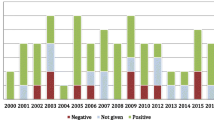Abstract
Recent reports on gene patenting claim that it has had a negative impact on medical research and have advocated changes in the law to address the negative effects the authors perceive to exist. These reports are based on anecdotal rather than objective evidence. In this article we seek to evaluate the impact of gene patenting objectively by examining, in overall terms, whether there has been a net cost or benefit to medical research from gene patenting.

Similar content being viewed by others
References
Heller, M. A. & Eisenberg, R. S. Can patents deter innovation? The anticommons in biomedical research. Science 280, 698–701 (1998).
Caulfield, T. Gold, E. R. & Cho, M. K. Patenting human genetic material: refocusing the debate. Nature Rev. Genet. 1, 227–231 (2000).
Andrews, L. B. Genes and patent policy: rethinking intellectual property rights. Nature Rev. Genet. 3, 803–808 (2002).
Nuffield Council of Bioethics. The Ethics of Patenting DNA [online] (cited 23.07.02) <http://www.nuffieldbioethics.org/patentingdna/index.asp> (2002).
Royal Society. Keeping Science Open: the Effects of Intellectual Property Policy on the Conduct of Science [online] (cited April 2003) <http://www.royalsoc.ac.uk/policy/index.html> (2003).
Doll, J. The patenting of DNA. Science 280, 689–690 (1998).
Arnold, B. E. & Ogielska-Zei, E. Patenting genes and genetic research: good or bad for innovation? Annu. Rev. Genomics Hum. Genet. 3, 415–432 (2002).
Warburg, R. J., Wellman, A., Buck, T. B. & Ligler Schoenhard, A. Patentability and maximum protection of intellectual property in proteomics and genomics. Pharmacogenomics 4, 81–90 (2003).
DiMasi, J. A., Hansen, R. W. & Grabowski, H. G. The price of innovation: new estimates of drug development costs. J. Health Econ. 22, 151–185 (2003).
McNamee, D. Seeking potential drugs in chemical libraries. Lancet 345, 1167–1168 (1995).
Grabowski, H., Vernon, J. & DiMasi, J. A. Returns on research and development for 1990s new drug introductions. Pharmacoeconomics 20 (Suppl. 3), 11–29 (2002).
EU Commission Report. Report from the Commission to the European Parliament and the Council: Development and Implications of Patent Law in the Field of Biotechnology and Genetic Engineering [online] (2002).
Evans Medical Ltd's Patent Reports of Patent Cases. Patent Case 517 (1998).
Walsh, J. P., Cohen, W. M. & Arora, A. Science and the law. Working through the patent problem. Science 299, 1021 (2003).
Walsh, J. P. in Patents in the Knowledge-Based Economy (eds Cohen, W. M & Merrill, S. A.) 285–340 (National Academies, Washington DC, 2003).
Thomas, S. M., Hopkins, M. M. & Brady, M. Shares in the human genome — the future of patenting DNA. Nature Biotechnol. 20, 1185–1188 (2002).
Stott, M. & Valentine, J. Impact of gene patenting on R&D and commerce. Nature Biotechnol. 21, 729–731 (2003).
Decision of the Opposition Division in European patent 0630405 (ICOS Corporation), dated 20th June 2001. Official J. Eur. Patent Office 293 (2002).
Crease, D. J. & Schlich, G. W. Is there a future for 'speculative' gene patents in Europe? Nature Rev. Drug Discov. 2, 407–410 (2003).
Genetic Inventions, Intellectual Property Rights and Licensing Practices, Evidence and Policies, Organisation for Econnomic Co-operation and Development [online] (cited 23.12.02) <http://www.oecd.org/dataoecd/42/21/2491084.pdf> (2002).
US Patent and Trademark Office utility guidelines [online] (cited 05.01.01) <http://www.uspto.gov/web/offices/com/sol/notices/utilexmguide.pdf> (2001).
Resnik, D. B. DNA patents and scientific discovery and innovation: assessing benefits and risks. Sci. Eng. Ethics 7, 29–62 (2001).
Cho, M. K., Illangasekare, S., Weaver, M. A., Leonard, D. G. & Merz, J. F. Effects of patents and licenses on the provision of clinical genetic testing services. J. Molec. Diagn. 5, 3–8 (2003).
Stuart, J. H. Graham. in Patents in the Knowledge-Based Economy (eds Cohen, W. M & Merrill, S. A.) 74–119 (National Academies, Washington DC, 2003).
Acknowledgements
With thanks to our colleagues, M. Lawrence, M. Rainey, D. Rosenberg and R. Thornley for their valuable counsel.
Author information
Authors and Affiliations
Corresponding author
Ethics declarations
Competing interests
M.S. and J.V. work in the corporate intellectual property department of GlaxoSmithKline
Related links
Related links
FURTHER INFORMATION
Rights and permissions
About this article
Cite this article
Stott, M., Valentine, J. Gene patenting and medical research: a view from a pharmaceutical company. Nat Rev Drug Discov 3, 364–368 (2004). https://doi.org/10.1038/nrd1348
Issue Date:
DOI: https://doi.org/10.1038/nrd1348
- Springer Nature Limited
This article is cited by
-
It’s About Scientific Secrecy, Dummy: A Better Equilibrium Among Genomics Patenting, Scientific Research and Health Care
Science and Engineering Ethics (2012)
-
Defining the spectrum of genome policy
Nature Reviews Genetics (2006)





